Lamont Bucks Advice in Sticking With Age, Educators

Audio By Carbonatix
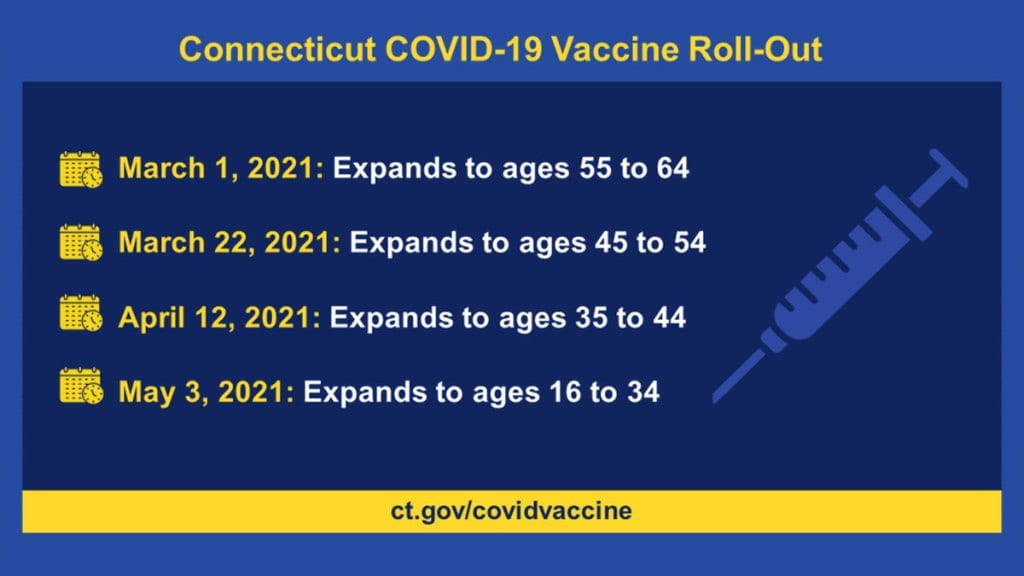
Vaccination eligibility in Connecticut will open for individuals 55 and older, as well as teachers and other schools staff and early childhood educators as of March 1.
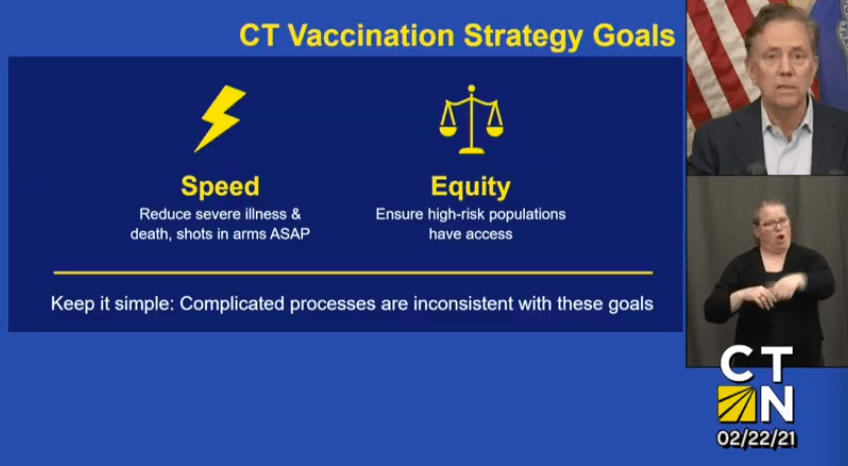
By Christine Stuart, CTNewsJunkie.com
Ronni Newton, We-Ha.com, contributed to this report.
Gov. Ned Lamont ignored advice from one of his vaccine subcommittees and will continue the rollout of the COVID-19 vaccine based largely on age with the exception of educators.
Here in Connecticut, authority over who makes it into the next phase ultimately rests with Lamont.
Lamont made the decision Monday to expand the age groups eligible for the vaccine from those ages 65 and up to individuals 55 years of age starting March 1, and then proceeding to the 45 to 54 age group by March 22, the 35 to 44 age group starting April 12, and 16 to 34 age group starting on May 3.
In addition to the age-based eligibility, pre K-12 school staff and teachers, and professional childcare providers will be eligible to receive the vaccine in March at dedicated clinics that will be set up specifically for those sectors.
West Hartford Superintendent of Schools Tom Moore said Monday afternoon that he is very happy to hear this news from the governor’s office. “We have been planning the logistics all along so we are ready,” Moore said. The dates for clinics for teachers and school staff in West Hartford will be announced as soon as the state gives the go-ahead.
The decision to administer vaccines by age is not in sync with guidance from state and federal advisory groups.
“In a perfect world, we would have enough doses of the vaccine to get it to all 3.6 million people in Connecticut right now, however each state is being given a very limited supply, which is why we must take this phased approach,” Lamont said in a press release.
He added: “My goal is to get as many people vaccinated as quickly as possible, and I believe this is the best path to meeting that challenge.”
Lamont’s vaccine advisory committee previously recommended that essential workers like grocery store, restaurant workers, and public transit workers, who continued to go to work at the height of the pandemic, should be next.
Lamont told reporters at a briefing Monday afternoon that it’s too complicated to determine who belongs to that group.
He said a lot of complications resulted from states that tried to “finely slice the salami,” and Connecticut will instead approach it according to the traditional business model “KISS” (keep it simple, stupid).
Lamont said it was too difficult to answer all the questions about who exactly was included in the essential workers groups and other previously mentioned priority populations laid out in guidance from the state and federal advisory groups. Would convenience store workers and big box retailers be included if grocery store workers were included? How do people prove they have a pre-existing condition?
“We understand there are individuals with some of those chronic conditions who want to get vaccinated,” Acting Public Health Commissioner Deidre Gifford said Monday.
But no exceptions will be made.
Gifford said those with chronic conditions are typically older.
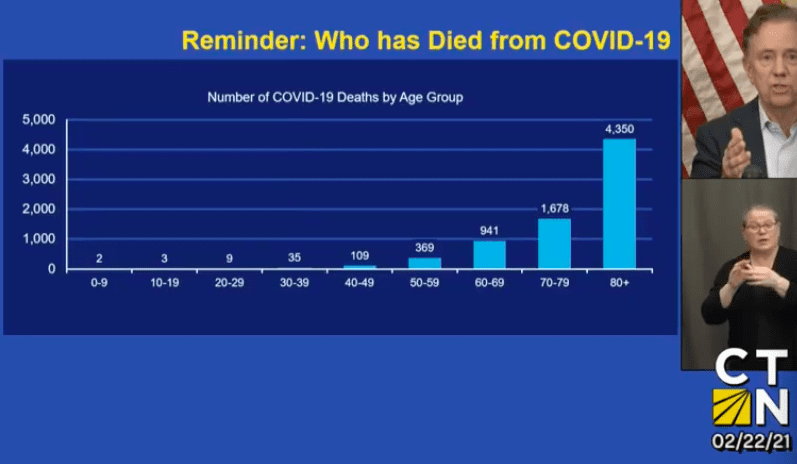
“It’s pretty tough to narrow each of these cohorts and determine what’s more serious than somebody else,” Lamont said.
Lamont said vaccinating by age group will get more people vaccinated faster.
Josh Geballe, Lamont’s chief operating officer, said that together, there are 650,000 residents who are either educators or in the 55-to-64 group. There are another 400,000 in each of the 54-to-45 and 44-to-35 age groups.
There’s no estimate on the number of people with pre-existing medical conditions that would qualify them for a vaccine before their age group.
“We know that people with underlying conditions skew into the older age category,” Geballe said.
Gifford said they understand frontline essential workers like grocery store clerks might be disappointed, but they will only have to wait a few more weeks.
“I would encourage people who were in one of those categories or have a chronic condition to look at the calendar and see where they are slotted in to our proposed strategy,” Gifford said.
Wayne Pesce of the Connecticut Food Association said he’s disappointed.
“Despite the heart-rending impacts of COVID-19, our state’s residents have been able to count on a safe, stable supply of food to sustain them over the last year. That would not have been possible without the selfless individuals who came to work every day so that others could feed their families,” Pesce said. “We will be having difficult conversations with our associates who believed they would be eligible for a vaccination in the next phase.”
Gifford said many people in these groups would have potentially waited longer than they will wait now under this proposal.
Lamont said they will have to prioritize equity in distributing the vaccine to underserved populations.
Some are saying Lamont’s decision is not equitable, but Dr. Reginald Eadie, president & CEO of Trinity Health New England and co-chair of the Governor’s COVID-19 Vaccine Advisory Group, defended it.
“Using age as an eligibility criterion makes it clear to all of our residents, especially those who have been disproportionately affected by COVID-19, that the vaccine is here, it’s available, and provides for an easier registration process to actually receive the vaccine,” Eadie said in a press release. “Education is important when it comes to addressing vaccine hesitancy, but we must also have a simple process to make sure those who need the vaccine receive the vaccine. This new timeline not only informs residents of when they can anticipate they will be eligible to be vaccinated, but it also provides vaccinators direction on when and where to target their own outreach and education efforts.”
Before these changes were announced Monday, Connecticut’s vaccination rollout had produced deep racial disparities, with Black residents less likely to be vaccinated than white residents in the 75 and older age category and overall.
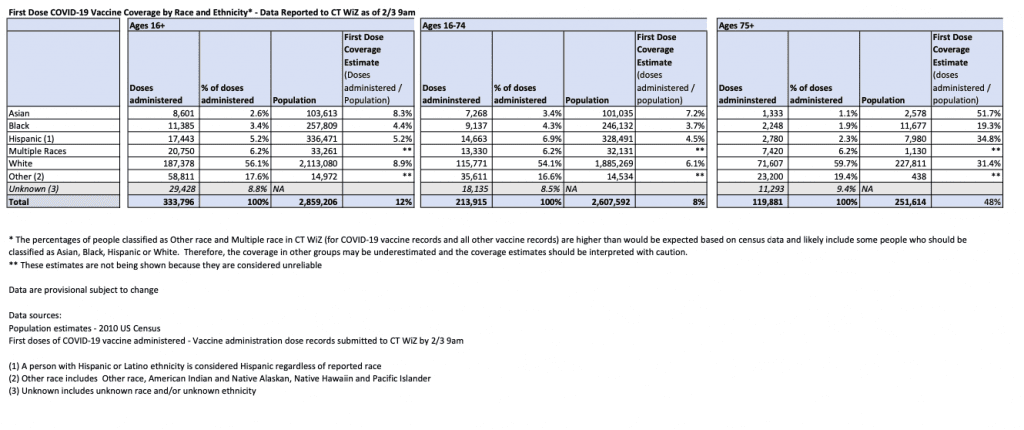
COVID-19 vaccination by race and ethnicity, as of Feb. 3, 2021. Screenshot from ct.gov
As of Feb. 3, the Department of Public Health released data that showed of the more than 333,800 doses it administered, only 3.4% went to Black residents while about 5.2% went to Hispanic residents and 187,000 doses or 56% went to white residents.
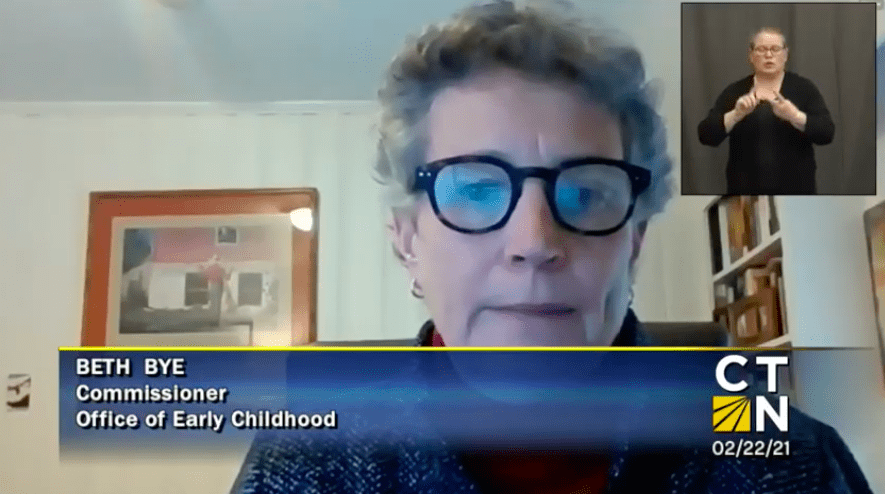
Commissioner of Early Childhood Beth Bye speaks about vaccination of professional childcare providers during a Feb. 22 press conference. Screenshot
Beth Bye, commissioner of Early Childhood, said during the governor’s Monday afternoon press briefing that she is very happy to see professional childcare providers included with educators. In addition, many who work in early childhood are women of color. “This is definitely a step toward equity for these workers,” Bye said.
In the press release Lamont says they also want to ensure that vaccines are administered to people living in the highest-risk communities in proportion to their population, but there’s no plan yet for how to go about doing that.
The vaccine program began in December with health care workers, followed by nursing home residents and staff and then those 75 and older and most recently those over the age of 65 in mid-February.
The committee made the recommendation in January. At the same time, they also recommended allowing individuals with one or more comorbidities to be added to the list of individuals who would be next in line.
Gifford said they are working with the chairs of their vaccine advisory committees and there is no reason to dissolve those groups.
“There’s been lots of consultation back and forth,” Gifford said.
Republished with permission from CTNewsJunkie.com, all rights reserved.
Like what you see here? Click here to subscribe to We-Ha’s newsletter so you’ll always be in the know about what’s happening in West Hartford! Click the blue button below to become a supporter of We-Ha.com and our efforts to continue producing quality journalism.



